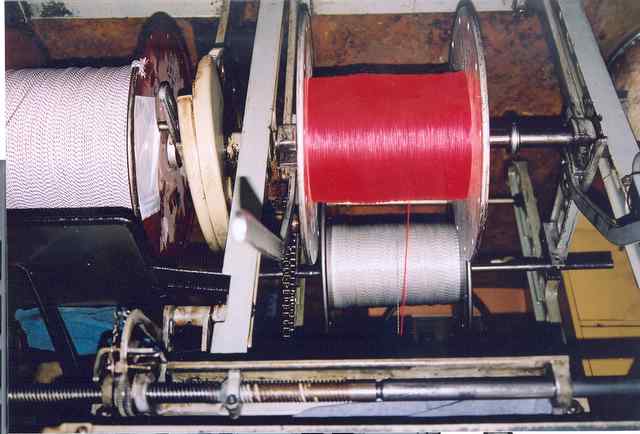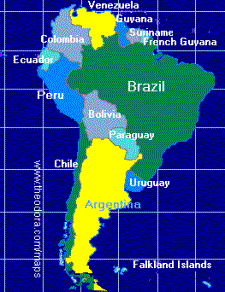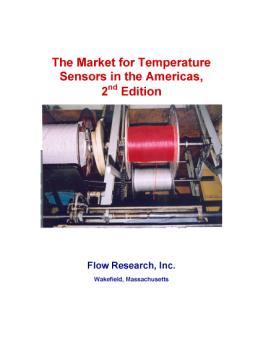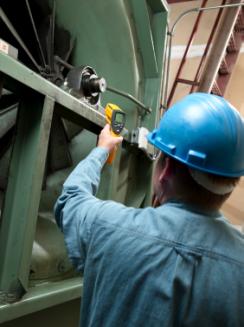

Thermocouples
RTDs
Thermistors
Infrared Thermometers
Fiber Optic Temperature Sensors
Thermowells
Flow
Research has just spent eight months working to answer that question.
We began by contacting more than 250 temperature suppliers, and
determined which ones are manufacturers of temperature sensors.
We then sent each company a detailed questionnaire asking about
their products and their company. We
then followed up with phone calls, interviewing many of these companies by
telephone. In the end, we analyzed all the data we collected and created
a complete picture of the market for temperature sensors in the Americas.
This study analyzes the temperature sensors market in the Americas. It includes a technology and product analysis, market share and market size data, and also provides in-depth segmentation of the market by various product and geographic categories. It also includes detailed market growth projections through 2010 for five types of temperature sensors, plus thermowells. Detailed market strategies are provided for suppliers, and 71 companies are profiled. Data is provided for the Americas, which includes the following geographic regions:
The Americas, including:
United States
Canada
Latin
America
This
study provides the following vital information about the temperature sensors
market:
Market size in dollars and units for each temperature sensor type
Growth forecasts through 2010 for each temperature sensor type
Market shares for each type of temperature sensor
Detailed product descriptions by supplier
Growth factors for the temperature sensors market
Growth forecasts for temperature sensors by industry
 Strategies
to employ to compete successfully in the temperature sensors market
Strategies
to employ to compete successfully in the temperature sensors market
Profiles of 71 suppliers to the temperature sensors market
Temperature sensor sales by distribution channel
Temperature sensor sales by customer type
|
Map
courtesy of www.theodora.com/maps,
used with permission |
|
This
study is important for many reasons, including the following:
1.
The study includes the main types of temperature sensors and accessories:
Thermocouples
RTDs
Thermistors
Infrared thermometers
Fiber optic temperature sensors
Thermowells
2.
We were able to determine the status of several trends we originally
identified in the first edition of this study, published in 2000. Among these
are a shift from contact to noncontact temperature sensors, and a shift
from wirewound to thin-film RTDs. We
now can quantify to what extent new temperature sensor technologies are
affecting the market.
3.
We determined how much the market has grown in the past six years, including
market size in dollars and units. We have this information for each temperature
sensor type. This study tells you whether the thermocouple market is growing or
declining, and how changes in the thermocouple market compare to changes in the
RTD and thermistor markets. With this knowledge, you can better evaluate the
prospects for your own temperature sensor products.
4.
This 450+ page study provides market shares for the temperature sensors market
as a whole, and for each type of temperature sensor. It tells you the major and
minor players in each market, and does so by geographic region. Along with this
are 71 company profiles that provide detailed financial and product information
on most of the suppliers to this market.
 5. It has been at least several years since a new study of this market
has been done. What's more, we believe we are the only market research
company currently studying this market. Not only is this new study the
result of a thorough examination of the temperature sensors market, we can also
see the market in light of the first edition of this study, published in 2000.
While some market research firms have neglected the temperature sensors
market, we recognize its importance and will continue to research and document
this market.
5. It has been at least several years since a new study of this market
has been done. What's more, we believe we are the only market research
company currently studying this market. Not only is this new study the
result of a thorough examination of the temperature sensors market, we can also
see the market in light of the first edition of this study, published in 2000.
While some market research firms have neglected the temperature sensors
market, we recognize its importance and will continue to research and document
this market.
Thermocouples. Thermocouples are the most widely used temperature sensor in industrial manufacturing environments. Thermocouples consist of two wires made of different metals that are joined at one end, called the measurement junction. At the other end of the conductors, a reference junction is formed. When the measurement junction and the reference junction have different temperatures, a continuous current flows in the circuit. The resulting voltage is a function of the difference in temperature between the measurement and the reference junctions. The amount of voltage depends on the types of metals used. A voltmeter or other device is required to interpret the voltage reading as a temperature value.
RTDs. Resistance temperature detectors, or RTDs, make use of the fact that resistance to the flow of electricity in a wire changes with temperature. Platinum is the most commonly used material for the wire. There are two types of RTDs: wirewound and thin film. Wirewound RTDs consist of wire wound on a bobbin, which is enclosed in glass or metal. For thin-film RTDs, a film is etched onto a ceramic substrate, and sealed. RTDs are more accurate and stable than thermocouples, but cannot be used to measure extremely high temperatures.
Thermistors. Like RTDs, thermistors also change resistance with changing temperatures, but they are more sensitive than RTDs or thermocouples. Thermistors change their resistance much more significantly than RTDs with changing temperature. However, this change is highly nonlinear. Because of their extreme sensitivity and nonlinearity, thermistors are limited to measuring temperatures of a few hundred degrees Celsius. They are less rugged than RTDs, further limiting their application.
Infrared Thermometers. Infrared thermometers are used to measure temperature when contact measurement, using thermocouples, RTDs, or thermistors, is not possible. For example, they are used to measure the temperature of moving objects, such as moving machinery on a conveyor belt. They are also used where contamination is present, for hazardous reasons, or where the distance is too great for contact sensors. Portable infrared thermometers are sued when it is desirable to measure temperature at a distance. Infrared sensors detect the infrared energy given off by materials. The most common design includes a lens to focus the infrared energy onto a detector. The amount of infrared energy is then converted into a temperature measurement according to specifiable units.
Fiber
Optic Temperature Sensors. Fiber
optic temperature sensors are a noncontact form of temperature measurement that
uses optical fibers in making temperature measurements.
Most fiber optic temperature sensors work by placing a
temperature-sensing component on one tip of the optical fiber.
The other end is attached to a measuring system that collects radiation
and processes it into a temperature value.
Technology
shifts are probably the single most important factor characterizing this market.
There is a shift away from contact temperature sensors towards noncontact
forms of temperature measurement. Handheld infrared thermometers measure temperature at a
distance. Fiber optic temperature
sensors, though more expensive, are used to measure temperature in hazardous
situations.
 Technology shifts are also occurring within the contact temperature
sensor market. This study shows how
the thermocouple, RTD, and thermistor markets today compare to the markets of
2000. It also allows you to compare the expected growth rates of these different
types of sensors through 2010. It
answers the following questions, and many more:
Technology shifts are also occurring within the contact temperature
sensor market. This study shows how
the thermocouple, RTD, and thermistor markets today compare to the markets of
2000. It also allows you to compare the expected growth rates of these different
types of sensors through 2010. It
answers the following questions, and many more:
·
Is
the thermocouple market growing or declining?
·
Which types of thermocouples are
most often used, J, K, E, N, or other types?
·
Which
types of RTDs are growing most rapidly in popularity, wirewound or thin film?
·
Which
are more often used, portable or fixed infrared thermometers?
·
What
are the fastest-growing industries for temperature sensors and why?
·
What
geographic region shows the fastest growth rate for temperature sensors?
Much
has changed among suppliers of temperature sensors since the first edition was
published in 2000. This study
brings you up-to-date on the many ownership changes among temperature sensor
suppliers that have occurred in recent years.
Most
importantly, this study tells you who are the leading suppliers for each
temperature sensor type. Market shares for each sensor type are provided for the
United States, Canada, and Latin America. The
study reveals two major suppliers of thermocouples and RTDs in Brazil, and
another one in Argentina. It also
tells you which company dominates the thermocouple and RTD markets in Canada.
Of course, the US market is also completely covered, for all types of
temperature sensors.
This study, with 71 company profiles, has more profiles than any previous Flow Research study. The list of companies profiled includes both traditional suppliers and newer entrants. The profile for each overview, a product description, and a statement of the company’s strategy and perspective. This page contains a list of companies profiled.
ABB
Abbeon Cal
Acrolab Ltd.
Alloy Engineering Company, Inc.
ARI Industries
Athena Controls
BetaTHERM Corporation
Burns Engineering
Chromalox
Cleveland Electric Laboratories
Conax Buffalo Technologies
Consistec
Convectronics
Cooper-Atkins Corporation
Cornerstone Sensors, Inc.
CSI International
C-Temp
Daily Thermetrics
Ecil
Electronic Development Labs
Emerson Process - Rosemount
Enercorp Instruments
Engelhard
Eurotherm Barber-Colman
Eustis Pyrocom
Exergen
Fiso
Technologies
Furnace
Parts
Gayesco
GE
Sensing
Harco Laboratories
Heraeus Holding GmbH
Honeywell Sensing and Controls
Idaho
Laboratories Corp.
IOPE Precision Instruments
IPITEK,
Inc.
Ircon,
Inc.
JMS
Southeast, Inc.
JUMO Process Control
Koenig-Pretempco
KRL / Bantry Components, Inc.
Land Instruments International
Linear Labs
Luxtron Corporation
Mac-Weld Machining
Marlin Manufacturing
Measurement Specialties
Mikron Infrared
Minco Products
Omega Engineering, Inc
Pyromation
Raytek Corporation
RdF Corporation
RTD Company
Sandelius
Sensor Scientific
Sensotec
Smart Sensors Inc.
Texas Thermowell Industries
ThermoCoax
Thermo Electric Co., Inc.
Thermo-Kinetics Company
Thermoteknix Systems Ltd.
United Electric Controls
U.S. Sensor
Vulcan Electric
Watlow
Weed Instrument
Wika Instruments, Ltd. / Alltemp
Williamson Corporation
YSI, Inc.
Flow
Research, Inc. 27
Water Street Wakefield,
MA 01880 (781)
245-3200 (800)
245-1799 (from the USA) (781)
224-7552 (fax)